Harold Davis's Blog, page 207
March 4, 2013
What some Botanique collectors have said
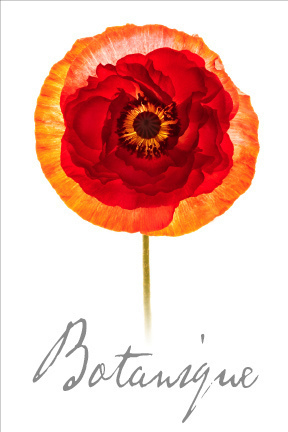
The display font used in Botanique is derived from Walt Whitman’s handwriting
Acclaimed as “origami in a box” and said to be “destined for major museums,” Botanique is an innovative artist project that astutely blends old craft and cutting edge new technologies to create an exquisite limited edition art book and art object that is completely unique.
Working together in their studio, legendary photographer and digital artist Harold Davis his wife, graphic designer Phyllis Davis, have combined advanced digital pigment printing with the luscious botanical art of Harold Davis. Every aspect of the project has been carefully designed and hand-crafted.
According to Popular Photography Magazine, the floral prints of Harold Davis “border on the spiritual.” Botanique contains twenty-one luscious floral prints that emerge delicately and seductively from the hand-assembled presentation box. The clam shell box measures approximately 9.25″ X 12.5″ X 1″ deep.
The Botanique project was originally successfully funded and crowd-sourced via a Kickstarter project.
Uniquely conceived and handcrafted using a blend of new and old techniques, Botanique is expected to be the first of a number of limited edition artist projects from the creative Davis photography and design studio.
Here’s what some of the collectors of Botanique have said:
“I didn’t open it until last night because I was really busy and wanted to take time to savor every page. It’s BEAUTIFUL! Thank you very much.”—S.M.
“I had time today to sit down and slowly admire each and every page of your amazing book. It is absolutely gorgeous…a true collector’s item…and is a reflection of the beauty and light within you both. I’m honored to be one of the people who has the privilege to own this book and will treasure it always.”—B.A.
”Arrived home from France this evening to find my copy of Botanique waiting for me . . . the book and accompanying prints are indescribably beautiful.”—B.G.
Click here for more information about Botanique, a limited edition artists book by Harold Davis.

March 3, 2013
Creative Effects in the Camera
I guess by now I am notorious for using Photoshop as part of my digital photography. After all, I’ve described my work as “painting using digital photographs as my medium.”
When giving a workshop, when asked whether an image has been “Photoshopped,” I reply, “Yes. Whichever image of mine you pick, the answer will always be, ‘Yes’!”.
So there is something that some people will find a bit unusual for me when I show a special-effect image that was created in the camera such as the Dance of the Tulips. Of course, good (and creative) camera technique is always important—whether Photoshop is involved or not!
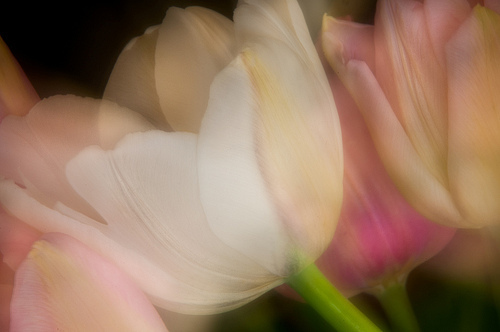
Dance of the Tulips © Harold Davis
Here’s how I made this image: First, I started with some beautiful Tulips from Thomas Farms, bought at the North Berkeley Farmer’s Market. I placed the tulips on a black background.
I’ve written previously about using my 18-200mm zoom lens with a 36mm extension tube to create a kind of poor person’s macro lens. This kind of setup can get you very close, and it has a neat soft focus feeling and cool bokeh. Of course, I wouldn’t use it if I wanted end-to-end precision macro sharpness. The odd thing is that optically what works best is to set the lens manually on infinity, find your distance, and then “focus” using the zoom ring.
My next step was to add approximately 8 f-stops of neutral density to the front of the lens so I could make quite long exposures, in the 5 seconds to 30 seconds range with the lens stopped down.
Finally, I timed each exposure so that the lens was fixed and “in focus” for about half the exposure, and then a carefully and smoothly rotated the zoom dial to get an out-of-focus effect for the remainder of the exposure.
Exposure data: 18-200mm zoom lens, starting at about 135mm, 36mm extension tube, 15 seconds at f/36 and ISO 100, tripod mounted.
Read about Bokeh and the Zen of Blur on my blog.

March 2, 2013
Tulip Wabi-Sabi
Wabi-sabi is a name for a Japanese philosophical and aesthetic movement with a key tenet of acceptance of the transient nature of all things. According to wabi-sabi, everything passes, and in that passage and imperfection lies the possibility of true beauty.
As I write in Photographing Flowers: Exploring Macro Worlds with Harold Davis, “in my work with flowers, I seek to understand how ephemeral life is, and to translate this sense into the emotion we associate with time passing—which is a deeper sense of true love than that associated with the first blush of early, often fickle and shallow, beauty.”
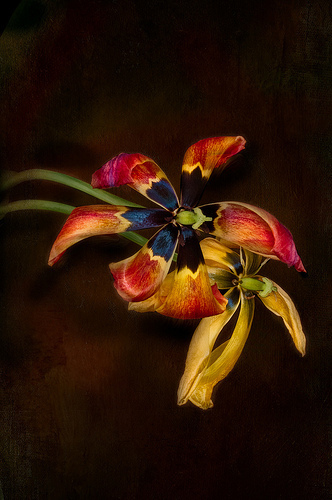
Tulip Wabi-Sabi © Harold Davis
In other words, the syllogism goes as follows:
Expressing emotion is one of the most important things any photo can do.
Flowers are often a vehicle in art for projecting our feelings about love and beauty.
If we are to progress beyond the infatuations of shallow youth towards the meeting of true minds that is mature love, then flowers as they age with all their imperfections are as much a valid subject as blossoms in the first sensuous blush of opening.
Flowers in decay are therefore a valid subject for photographic interpretation.
With this composition of Tulip Wabi-Sabi, I watched my tulips over the course of a week as they gradually matured, lost a few petals, and curled—beautiful at every step of the way.
The resulting image, shot against black velvet, is a little mysterious and exotic, as though birds with colorful plumage were descending through the dusk. No birds, these are just my lovely tulips, subject to gravity and aging like all of us.
Exposure data: 85mm tilt-shift macro, nine exposures at shutter speeds from 1/60 of a second to 8 seconds, each exposure at an effective aperture of f/64 and ISO 200, tripod mounted; exposures processed via Adobe Camera RAW and Nik HDR Efex Pro, and finished in Photoshop.

February 27, 2013
Tiptoe through the tulip
The tulips that I found last week at the North Berkeley Farmers Market have transmogrified into fantastical shapes and forms as they age and illustrate wabi-sabi in action. Like the anemones, these flowers started out somewhat closed, and grew into their beauty as they opened.
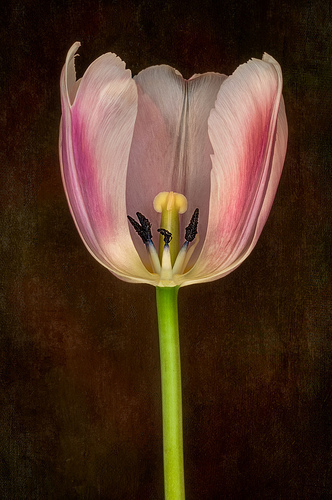
Tulip Within © Harold Davis
With this tulip, a petal fell to the ground while the rest of the flower was still radiant. This missing petal allowed me to peer in, and to capture the beauty within the tulip.

February 26, 2013
Steel Wool
Sometimes you don’t have to go far to find something exotic to shoot, like this close-up portrait of industrial-grade steel wool, purchased at Costco.
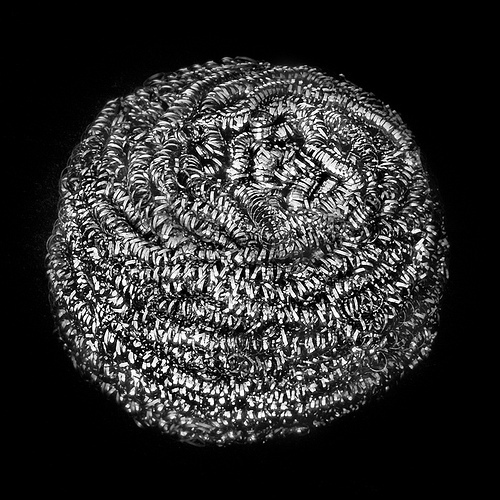
Steel Wool © Harold Davis
Exposure data: 85mm tilt-shift macro, 1.3 seconds at an effective aperture of f/64, ISO 100, tripod mounted; processed in Adobe Camera RAW, Photoshop, and Silver Efex.

February 23, 2013
Photographing your kids
Pity the poor children of the shoemaker—who go around perpetually down at their heels. Although photographic projects, clients, flowers and more beckon, such is not the case for my kids when it comes to imagery. Like every proud Papa I love to photograph my four kids, and I get the opportunity to indulge in photography of my kids in their casual moments. Oddly, my first job as a professional photographer was making formal portraits of kids, with backdrops and lighting—and I didn’t enjoy it nearly as much as I do photographing kids spontaneously and casually.
For example, here’s a casual “grab shot” of my wonderful eight-year-old Mathew enjoying his bubble bath.

Mathew in the bath © Harold Davis
If you want to take casual shots of your kids—or anyone else’s kids—the key is to keep things spontaneous and fun. If you interrupt the flow of what the child is doing to bring out photographic equipment, or make them pose, the moment is lost. What better way to be spontaneous than to involve your kids in the process of photography by showing them on the LCD how cool they are, or, if they are making funny faces, the humor in the photos?
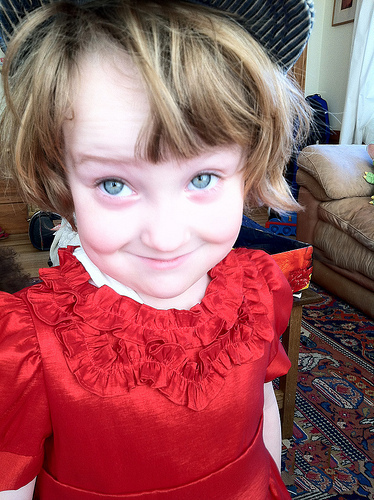
Katie Rose (iPhone photo) © Harold Davis
Spontaneity means acting on the spur-of-the-moment. My iPhone is the camera I always have with me, and perfect for these impromptu times, when dragging out the DSLR would ruin the flow of play. Remember that the goal of this kind of photography is not to achieve technical perfection. It is to capture a snapshot of your kid in the moment. Mobile phone cameras these days are certainly good enough for most kinds of casual photography, as you can see in the shot of Katie Rose above.
You’ll find more about photographing kids (and grown people too) in my book Creative Portraits: Digital Photography Tips & Techniques.
February 21, 2013
Floral Sunset
It’s hard to imagine two subjects that are more over-photographed than sunsets and flowers. Of course, there’s a reason that something is a popular subject for photography. It’s wonderful to make images of flowers, and as I ask in the introduction to Photographing Flowers: Exploring Macro Worlds with Harold Davis, “How can we not want to capture this ephemeral and bold stand against the entropy and chaos of the universe?”
The virtues of sunset to the serious photographer are also greater than one might suppose based on all the awful images of sunsets out there, and also the disdain of the professional cadre for imagery that depicts the setting of the sun. Each and every sunset reminds of us of our place in the solar system, and also the passage of time. I am reminded of Galen Rowell’s remark that every photographer only has a certain and fixed number of sunsets—so one should witness every single one of them. This may be overkill, but leaving metaphysics aside it is true that some of the most interesting light in the field occurs right around sunset.
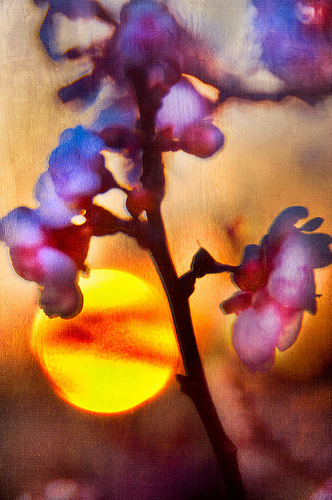
Setting Sun and Cherry Blossoms © Harold Davis
So as a photographer I love the sunset time of day. Also, it’s fun to turn the double cliché on its head, and approach combining sunsets and flowers in an unusual way. With this shot of a setting sun seen through a cherry blossom I relied on the fact that throwing the sun way out-of-focus makes it appear much larger. With my camera on my tripod, I used my 105mm macro lens combined with an extension tube. My aperture was wide open, and I focused on the very close cherry blossom to make the sun seem even larger than life. I finished the image with a texture overlay to make it seem even more painterly and dreamy.

February 19, 2013
The Bristlecone Pines Endure
Above 10,000 feet in the arid White Mountains in eastern California the ancient Bristlecone Pines thrive. In this extreme environment wood decomposes slowly, and these trees can look more dead than alive. In this state a tree can live on for centuries, the spark of life embedded within the enduring structure of wood.
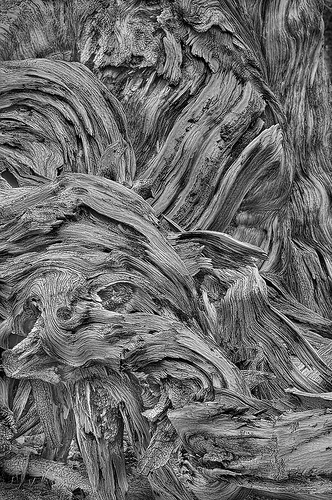
Endurance © Harold Davis
Coming upon a composition of apparently dead wood formed by a living Bristlecone Pine, I could see that I wanted a black and white image that showed the spectacular patterns of wood grain—and also that the ability to make this image was beyond the tonal range of any single capture. So I resolved my dilemma by making multiple captures, and taking the image from mundane to striking in its tonal variety.
Exposure and processing data: 200mm macro lens, six exposures at shutter speeds ranging from 1/500 of a second to 7/10 of a second, each exposure at f/32 and ISO 200, tripod mounted; RAW files processed in Adobe Camera RAW and Nik HDR Efex Pro with post-production in Photoshop, monochromatic conversion using Photoshop and Nik Silver Efex Pro.

February 16, 2013
Anemones Redux and more floral panos on the way
Briefly noted: Here’s another shot of anemones to go with my earlier anemones composition. I’m working on the post-production of two new anemone panoramas. Of course, this kind of post-production work takes time—particularly when it must be fit in the context of everything else that I do.
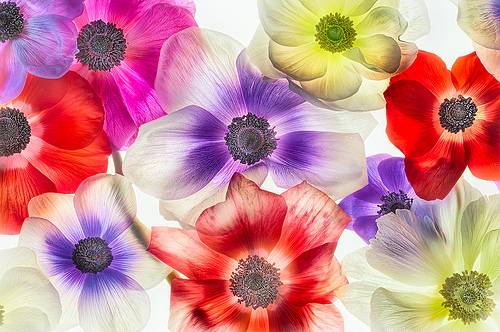
Anemones 2 © Harold Davis
I hope the new floral panos come out as well as the Star Magnolia panorama and Peonies panorama in Botanique!

February 12, 2013
Introducing Botanique
Introducing, drum roll, Botanique. I’m pleased that Botanique, my handmade, limited edition artist book of botanical prints is seeing the light of day! It’s very exciting when a new project is made physically manifest—particularly one that embodies as much craft and innovation as Botanique.
Yesterday Phyllis and I attended Codex, a show of handmade books. There were many wonderful objects in the show—but not much good photography, nor any books that I could see created using a pigment printer (letterpress was probably the predominant printing medium). So we look towards the future while acknowledging the past!

Botanique includes three oversize pull-outs like the Star Magnolia panorama shown on Unryu washi paper
Acclaimed as “origami in a box” and said to be “destined for major museums,” Botanique is an innovative artist project that astutely blends old craft and cutting edge new technologies to create an exquisite limited edition art book and art object that is completely unique.

The display font used in Botanique is derived from Walt Whitman’s handwriting
Working together in their studio, legendary photographer and digital artist Harold Davis his wife, graphic designer Phyllis Davis, have combined advanced digital pigment printing with the luscious botanical art of Harold Davis. Every aspect of the project has been carefully designed and hand-crafted.
According to Popular Photography Magazine, the floral prints of Harold Davis “border on the spiritual.” Botanique contains twenty-one luscious floral prints that emerge delicately and seductively from the hand-assembled presentation box. The clam shell box measures approximately 9.25″ X 12.5″ X 1″ deep.
The Botanique project was originally successfully funded and crowd-sourced via a Kickstarter project.
Botanique is presented in a limited edition of 25 copies, with 5 Artist Proof copies. Each copy in the edition is hand-signed and numbered. Copies 1-10 are spoken for, but if you (or someone you like very much) enjoys floral art and beautiful things please consider one of the remaining copies. Please contact my studio for current pricing and availability.
Links for more information:
The Botanique prospectus
Contact Harold Davis studio
Botanique press release
Botanique Kickstarter campaign
A box for Botanique (blog story)
Hot off the press (blog story)
Assembling the Botanique prototype (blog story)




